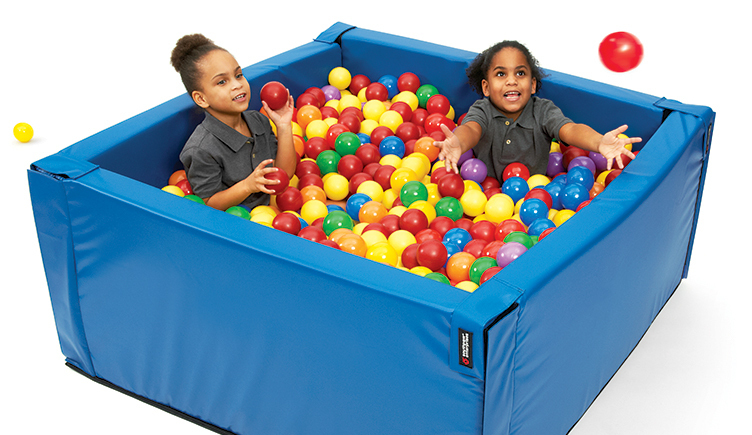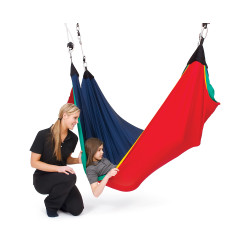Pediatric occupational therapists use vestibular equipment, such as Southpaw’s Platform and Rainbow Acrobat Swings, to address a variety of concerns for children and families, including sensory processing, motor skills, coordination and self-regulation. Dynamic, moving equipment like this produces enhanced vestibular sensations that can be used in collaboration with the child to address specific concerns and improve quality of life.
Some children may be working on improving their ability to plan and execute motor movements, and using the Platform Swing provides increased sensations and information about where their body is in space and how their body is moving. While on the Platform Swing, a child can sit, stand or kneel while practicing maintaining balance or a more complex motor skill, like catching and throwing a ball.
Alternatively, other children may be working on regulating their emotional responses to activities or movement. For example, a child who is anxious may experience calming sensations while gently swinging side to side in the comforting compression of the Rainbow Acrobat Swing. A child who is low energy or sleepy may experience alerting sensations when lying on their stomach and pushing in circles in the support of the Rainbow Acrobat Swing.
Using sensory equipment effectively and safely to address sensory processing challenges requires education, practice and a thorough understanding of the sensory experiences produced. Without personal experience, it can be difficult to understand what a child is feeling and doing during activities on the swing. Future occupational therapists need access to equipment so they can gain real-life experience with the sensations and skills that occur when using the equipment in sensory processing integration interventions. A Custom Support Structure and Custom Floor Mat fit to the size of a classroom or lab space provide an opportunity for future occupational therapists to safely learn how to use the equipment and their personal experience to bring textbook and classroom learning to life.
Are you looking for specific ways to teach sensory processing interventions in an engaging way to adult learners? Occupational therapy or other social and health professional learners can practice tracking how their own regulation changes before, during and after using swings and other sensory equipment. To encourage problem-solving and clinical reasoning, they can challenge learners to identify multiple ways to use a piece of equipment for a variety of concerns, such as using the Rainbow Acrobat Swing for two different children. Case studies can also encourage learners to use clinical reasoning to create client-centered sensory activities using sensory equipment. Learners can complete an assessment or checklist to learn about their own sensory processing needs and create sensory diets and environment modifications for themselves or peers.
Many children and families benefit from swings and other sensory equipment in safe, effective interventions led by trained therapists or professionals. Future therapists and professionals benefit from real-life experience with this equipment during training to develop the skills needed to provide more children and families with fun and successful sensory interventions.



